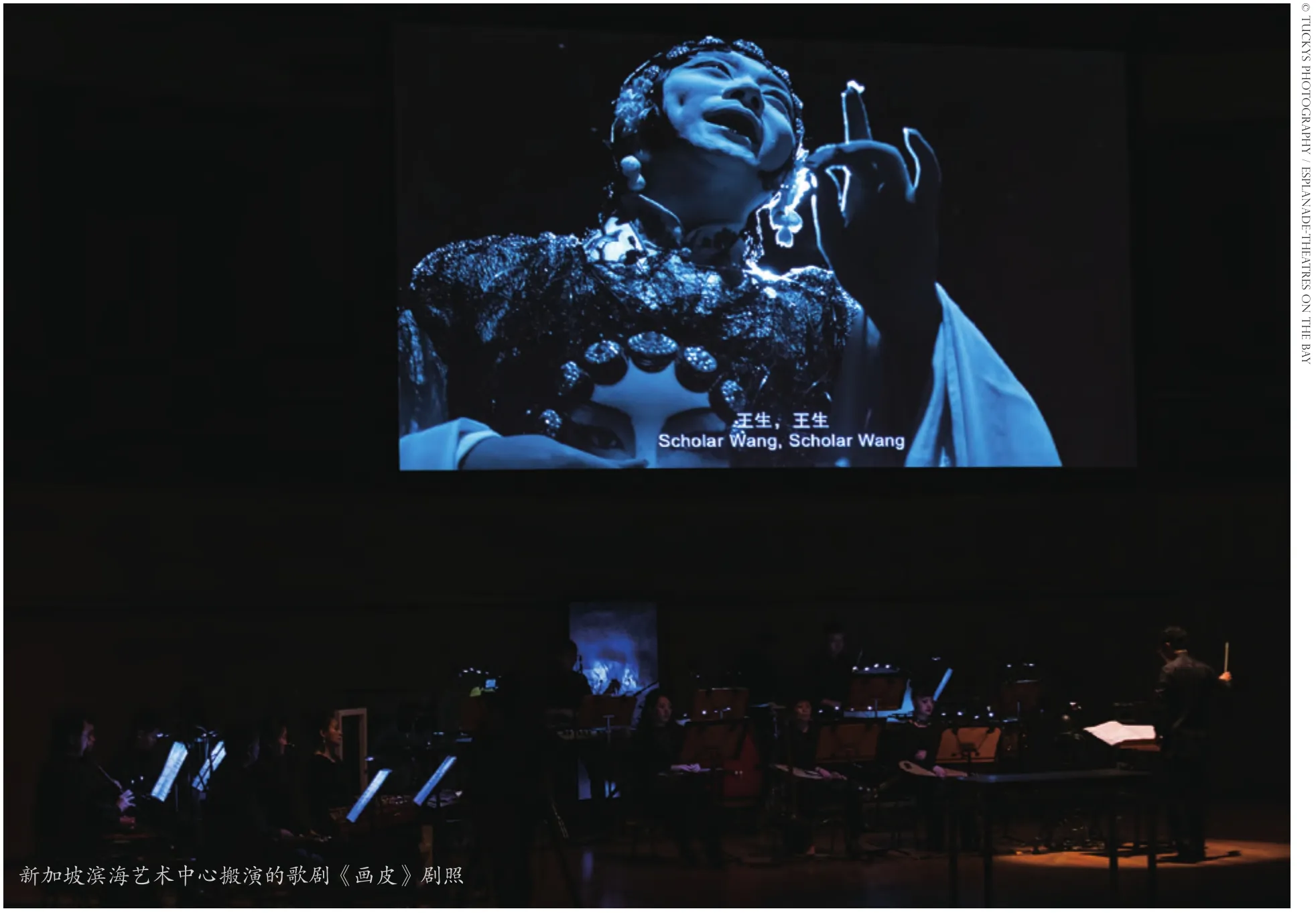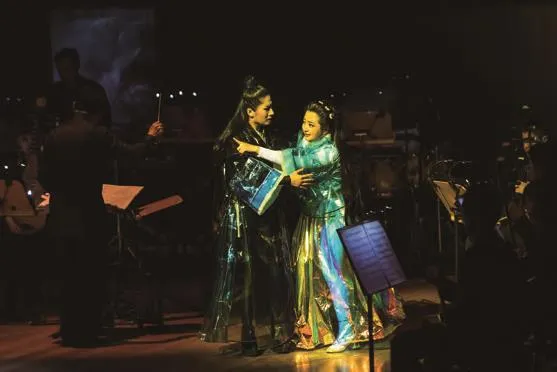半舞台歌剧制作:最大限度地运用音乐会舞台
文:司马勤(Ken Smith) 编译:李正欣

我身处乐团后方,坐在乐手后面那些合唱队平时占用的座位上,双眼凝望着勒内·雅各布斯(René Jacobs)的正脸。我看看手上的门票,票面上的确印着“VIP”字样。通常买票入场的观众,不会花大价钱看60人乐团的背影。我不是不尊敬雅各布斯大师或者无视他在音乐上的卓越成就,但我宁愿观赏两位女高音——波丽娜·帕兹蒂斯卡(Polina Pasztircsák)与奥利维亚·维莫伦(Olivia Vermeulen)的正面,她们分别饰演唐娜·安娜与唐娜·埃尔维拉。
弗莱堡巴洛克古乐团在深圳音乐厅演出音乐会版《唐乔瓦尼》期间,饰演莱波雷洛的男中音罗伯特·格莱多(Robert Gleadow)突然跑到舞台后方,对着我邻座的一位女观众演唱,让她也成了演出的一部分——这是名副其实的VIP待遇无疑。
讨论音乐会版歌剧的文章已屡见不鲜,我也曾经贡献了不少。时至今日,大部分有头有脸的交响乐团在自己的演出季里都会在歌剧这个“大水池”里“踩踩水”。原因显而易见,或者说太浅显了。在没有布景或服装分散注意力的情况下,大家能够聚精会神地专注于音乐里蕴藏的奥妙。因此,当“莱波雷洛”突然冲过来,在观众席里随机挑选下一位唐乔瓦尼要勾引的美女时,这个引人入胜的故事又让你有了新的体验。
我决定在深圳看本年度“一带一路”国际音乐季里弗莱堡古乐团的演出,原是一时冲动之举。其实,这几年来我都渴望有机会看看这个古乐团是怎样演绎莫扎特的。早在2016年,雅各布斯在纽约莫扎特音乐节(Mostly Mozart Festival)演出《伊多梅纽》(Idomeneo),当时业界内外都雀跃不已。除了常住欧洲大陆的观众,大部分乐迷仅能通过唱片了解过雅各布斯与弗莱堡巴洛克古乐团的艺术造诣(把歌剧唱片界定为“音乐会版歌剧”,没有人会有异议吧)。

弗莱堡巴洛克古乐团演出的音乐会版《唐乔瓦尼》剧照
雅各布斯过去是一位假声男高音,理所当然地会聚焦在声乐演出上,这不足为奇。我也预料得到,因为他还是位古乐专家,自然而然地会很尊重作曲家原本的创作意图。我们平时习以为常的莫扎特——尤其是演奏速度——在雅各布斯的指挥棒下,都被动摇了。演奏速度虽然像是在赛马一样,但唱词还是听得一清二楚。有时候,甚至会觉得旋律故意停了下来,让我们好好享受声乐的美妙时刻。饰演唐乔瓦尼的约翰尼斯·威瑟尔(Johannes Weisser)演唱那首著名的“香槟咏叹调”时,就显得深思熟虑,而少了平常的那种喧闹。
雅各布斯选择的演奏速度要是真的配上布景服装,肯定会被它们拖累。我认为深圳的演出最让人刮目相看的是:观众接触了一批在大歌剧院无法充分发挥才华的欧洲演员。年轻美貌的他们演出时使出浑身解数、行动敏捷——无论是纯熟的嗓音技巧(能追得上雅各布斯带领的轻快节奏),还是他们的肢体动作,经常要从舞台的一端奔跑到另一端。
***
2月底,一版截然不同的“歌剧音乐会”在新加坡上演。滨海艺术中心的华艺艺术节搬演了歌剧《画皮》(Painted Skin)。这部作品去年10月在上海的首演更像是一台多媒体剧场演出。导演易立明这次为新加坡的制作被定义为“歌剧音乐会”——舞台上只有一个投影屏幕。
别的不说,这次的经验让我们领略到在不同音乐文化背景下,“歌剧音乐会”的定义也有很大的差别。《画皮》的服装十分讲究,但道具不多。要说真有什么的话,郝维亚创作的这一部联篇创作曲式歌剧与传统戏曲有不少雷同,《画皮》让人联想起京剧“一桌二椅”那种简洁的美学观。
新加坡华乐团也强调了其他的共鸣点。乐团在舞台上没有依据西方的乐团编制来排位。个别小组被编排在舞台不同区域,看起来有点像中国传统戏院的格局。郝维亚在配器方面凸现了传统乐器的演奏法,却又把它们独特的音色延展出来,所营造出的音乐世界就像阿尔班·贝尔格(Berg)与安东·韦伯恩(Webern)(添加了一丝西方恐怖电影效果)。

左页、下:香港艺术节歌剧《白蛇传》剧照
要是跟弗莱堡的《唐乔瓦尼》比较,《画皮》的第四堵墙①第四堵墙(fourth wall),戏剧术语。在镜框式舞台上,通过人们的想象位于舞台台口的一道实际上并不存在的“墙”。它是由对舞台“三向度”空间实体联想而产生,并与箱式布景的“三面墙”相联系而言的。它的作用是试图将演员与观众隔开,使演员忘记观众的存在,而只在想象中承认“第四堵墙”的存在。相对牢固,到了最后才被打破。女中音董芳(饰王生)、女高音李晶晶(饰王夫人)与京剧乾旦刘铮(饰女鬼妫嫣)在他们固定的舞台区域演出,他们之间的互动只限于故事或音乐的需要。刘铮也有几个像是前文中提到的莱波雷洛与观众交流的段落。这些行为主要为了展现《画皮》编剧王爰飞剧本里对女鬼装模作样的描述与反讽,与罗伯特·格莱多的故意抢戏有点不同。和《唐乔瓦尼》一样,到了尾声,《画皮》的演员消失于台下,融入了观众席中。
但这真的是我们通常定义的“歌剧音乐会”吗?我猜,当晚在滨海艺术中心的观众完全抓得到这场“音乐会”的戏剧性要点。
***
数周后,《画皮》找到了一个可谓是志同道合的伙伴:香港艺术节搬演了歌剧《白蛇传》(Madame White Snake)。这两部作品都源于中国古代的奇幻传说,如今为了当代观众而更新了展现的形式。两者都尝试融合中国与西方的声乐方式:歌唱方面注入了像勋伯格式诵唱(Sprechstimme),从某种程度上模仿京剧念白的效果。(《白蛇传》的例子更为复杂,因为林晓英写的是英语剧本,并用英语演唱。)
这两部歌剧都用了四幕剧的结构,连贯演出,没有中场休息。两部作品都有借鉴演员反串的传统,无论是男扮女或者女扮男——《白蛇传》最明显的案例,是用了假声男高音迈克尔·马尼亚奇(Michael Maniaci,他本人自称为“男性女高音”)扮演小青(青蛇),旋律风格偏向无调性。
说实在的,“音乐会”版《画皮》一幕里的舞台动作要比整套《白蛇传》的更多。《白蛇传》大部分的感官刺激来自导演迈克尔·考兹(Michael Counts)的视觉设计——灯光与动画投影深化了舞台动感以及感情表现力。林晓英把古老的民间故事现代化,削弱了批判妖精的成分,变成一个跨越种族的爱情故事。周龙谱写的四幕音乐都具有令人佩服的风格对比——这部作品于2011年赢得普列策音乐大奖,周龙也是首位获得该奖项的中国出生的作曲家,但是真正把音乐与唱词融合起来的是考兹的视觉设计。
可惜,《白蛇传》在香港亮相前一周,由卡里希托·比埃托(Calixto Bieito)导演的《汤豪舍》不如人意:瓦格纳的音乐与舞台上所发生的一切没有任何“融合”可言。这位经常引起评论分歧的导演竟然让香港的歌剧界各类群体团结一致了:评论家、电台名嘴、互联网上的讨论立场一致,清一色地批评比埃托彻底漠视了瓦格纳的剧本与音乐。有人更致信《南华早报》,呼吁香港艺术节在节目选择方面需要加倍谨慎。观众们做何反映?他们用行动说话:中场休息后,观众席顿时空了很多。

左页、下:香港艺术节歌剧《白蛇传》剧照
这种状况真令人扼腕叹息!因为乌尔夫·席尔默(Ulf Schirmer)率领的莱比锡布业大厅乐团与莱比锡歌剧院合唱团带来了不但细腻,更是原汁原味的瓦格纳式演绎,在亚洲地区实属罕见。他们3月2日的演出一气呵成,简直可谓是天衣无缝。乐团把焦点归于音乐织体藏着的旋律而不只是表面的光鲜。乐手简直是跟歌唱家同频率呼吸,同步配合乐句的线条。
丹尼尔·弗兰克(Daniel Frank)演绎汤豪舍,他驾驭舞台的秘诀,不只靠音量而是凭他那听起来舒服但响亮的声线。马库斯·埃沙(Markus Eiche)是一位刚毅、靠谱的沃夫拉姆。而女演员方面,要在凯特林·格灵(Kathrin Göring)饰演的红发维纳斯与伊丽莎白·斯特里德(Elisabet Strid)饰演的形象健康的金发伊丽莎白二人之间挑选其一——标准纯粹在于她们的嗓音。斯特里德明显是赢家,她的演出丰富而立体;格灵本应是个妖妇,却显得过分贞洁。
如果在神圣和亵渎之间做出选择是一种典型的困境,为什么这个抉择显得这么容易?维纳斯的巢穴本应代表着肉体的诱惑,但看起来却无精打采。汤豪舍回归至“纯真”的场景中,一班兄弟用鲜红的血液涂在他胸膛上,勾画了一个十字架。这看起来有点像单身汉派对的玩意,也像异教徒的狩猎祭礼。真的,哪一方更有乐趣?
倘若比埃托营造的景象——与瓦格纳背道而驰的导演手法,令你怀疑他有没有搞明白故事情节,这个制作中视觉转换的节奏与现场音乐的演出从头到尾都脱了节。无论如何,他有意无意地给了我一个念头。我很少很少看罢一个歌剧制作后,宁愿它是一场“歌剧音乐会”。
So I'm behind the orchestra—really behind, sitting in the choir stalls—looking at the face of René Jacobs.I glance down at the tickets to remind myself that they really say “VIP seats.” People don't usually pay big bucks to look at the backs of 60 musicians. And nothing against Maestro Jacobs or his prowess on the podium, but I'd rather be facing Polina Pasztircsák and Olivia Vermeulen, the sopranos singing Donnas Anna and Elvira.
But at some point at the Shenzhen Concert Hall during the Freiburg Baroque Orchestra's concert performance ofDon Giovanni, the baritone Robert Gleadow (playing Leporello) runs to the back of the stage and starts directly addressing a woman a few seats over from me, making her part of the show.VIP seating, indeed.
Much has been written about opera in the concert hall—some of it by me—and by now few symphony orchestras of any stature will get through an entire season without dipping their toes at least once in the operatic pool. The reasons should be obvious. Too, obvious, perhaps. We're all so focused on listening to the music with such intensity,undistracted by sets and costumes, that if Leporello comes around and singles out someone in the audience who might be the Don's next conquest,it shocks you back into thinking what the story is really about.
Though I attended the Freiburg's appearance at Shenzhen's Belt and Road Festival on a last-minute impulse, I'd been hankering to see what they do with Mozart for some time. Back in 2016, Jacobs had generated some excitement in New York withIdomeneoat Lincoln Center's Mostly Mozart Festival.Most people outside of Europe, though, know his work with the Freiburg mostly from CD recordings(which pretty much by definition, fall under “concert opera”).
It's not surprising that Jacobs, a former countertenor, focuses so heavily on the singing. Nor is it a shock that, given his experience in early music,he's concerned with a piece's original intentions.Much of what we expect from Mozart—particularly tempos—is shaken under Jacobs's baton. The music often races at a clip, but never at the expense of the text. Sometimes it even seems to bask in the moment. When Johannes Weisser's Giovanni sang his “Champagne Aria,” the performance was more reflective that riotous.
At these tempos, sets and costumes would simply get in the way. If nothing else, the evening introduced the audience to a roster of European singers whose particular gifts would never be fully utilized in the largest opera houses. They were,throughout the cast, young, attractive and limber—both vocally, from Jacobs's musical pacing, and physically, from having to run frequently from one side of the stage to the other.


左、右:新加坡滨海艺术中心搬演的歌剧《画皮》剧照

左、右:新加坡滨海艺术中心搬演的歌剧《画皮》剧照
***
A much different venture into “concert opera”took place in Singapore in late February whenPainted Skinappeared at the Esplanade's Huayi Festival of Chinese Arts. As a marked contrast to the opera's premiere last October in Shanghai, where director Yi Liming's production was something of a multimedia showcase, the Singapore performance was billed as “an opera in concert,” its projections limited to a single screen.
If nothing else, the experience brought home the idea that “concert opera” means different things in different musical cultures. InPainted Skin, costumes were certainly elaborate, props suitably minimal.If anything, Hao Weiya's through-composed opera seemed remarkably akin to traditionalxiqu, evoking the “one-table-two-chairs” aesthetic of Peking opera.
Further connections were enhanced by the Singapore Chinese Orchestra, which instead of its usual placement in Western symphonic formation was spread across the concert stage in various stations much like musicians in traditional Chinese theatre. So too did Hao's score draw its own associations, delving into the playing techniques of traditional instruments while extending their distinctive timbres into the sound world of Berg and Webern (with echoes of Western horror films).
Compared with the Freiburg'sGiovanni, however,the fourth wall remained intact much longer. Mezzosoprano Dong Fang (as Scholar Wang), soprano Li Jingjing (as his wife) and the Peking opera performer Liu Zheng (as the ghost Gui Yan) generally stayed in their respective spaces, mingling even among themselves as little as the story and score required. Liu did have a few Leporello-like moments,reaching into the ironies of Wang Yuanfei's text with more obvious camp than Gleadow's hammy scene-stealing. And as inGiovanni, characters do eventually disappear into the seating area and interact with the audience.
But was this really a “concert opera” as we normally define it? I suspect that few people at the Esplanade felt that they were missing anything by merely attending a musical performance.
***
A few weeks laterPainted Skinfound a kindred spirit, so to speak, inMadame White Snakeat the Hong Kong Arts Festival. Both operas were old fantasies of Chinese imagination modernized for contemporary audiences. Both tried to negotiate differences between Western and Chinese vocalism with extended passages of Schoenberg-likeSprechstimmeto simulate the effect of stylized Peking opera oration. (This was rather more complicated inMadame White Snake, given that Cerise Lim Jacobs's text was written and performed in English).
Both operas maintained a four-act structure,running about 100 minutes without intermission.And both made reference to gender-bending casting in both theatrical cultures, where men often play women's roles and vice-versa—the chief example here being countertenor (or as he prefers to be called, “male soprano”) Michael Maniaci as the green snake Xiao Qing, who bore the brunt of the atonal vocal lines as well.

歌剧《汤豪舍》第二幕,伊丽莎白·斯特里德的饰演伊丽莎白
There was, truth be told, much more stage movement in a single act of the “concert”Painted Skinthan the whole ofMadame White Snake. Most of the stimulation came from director Michael Counts's visual design, an amalgam of lighting and animated projections that unfolded with great physical and expressive depth. While Jacobs modernizes the folk legend into a less judgmental interspecies romance, and Zhou's score moves from act to act with remarkable musical contrast—the opera was awarded the 2011 Pulitzer Prize for Music,making Zhou the first Chinese-born composer to win the award—it is Counts's visual design that truly merge music and text together.

左页:歌剧《汤豪舍》第二幕场景
Would that we could say the same for Calixto Bieito's production ofTannhäuser, which appeared in Hong Kong the week before. In his own way, the divisive director actually brought Hong Kong's opera community together. Critics, radio commentators and internet chatter alike united against Bieito's blatant disregard for Wagner's text and score. A letter to theSouth China Morning Postcalled for greater due diligence from the Hong Kong Arts Festival in its selections. Audiences voted with their feet, with a notable exodus at the interval.
This was a pity, not least because Ulf Schirmer led the Gewandhaus Orchestra and the Oper Leipzig Chorus in one of the most subtly idiomatic Wagner performances yet to reach this part of the world. On March 2 the performance reached nearseamless cohesion, with the orchestra focusing less on the shimmering surface than on the music's inner threads. Players practically breathed with the singers in matching the musical line.
As Tannhäuser, Daniel Frank filled the stage less with sheer power than in pleasantly bright tone colour. Markus Eiche was a suitably sturdy and dependable Wolfram. As for the women, the choice between Kathrin Göring's brunette Venus and Elisabet Strid's wholesomely blonde Elisabeth—both clad in near-identical spaghetti-strap dresses—became a purely vocal affair. Strid was the clear winner, with a rich, rounded performance in stark contrast to Göring's surprisingly chaste temptress.
If choosing between the sacred and profane was such an archetypical dilemma, why did it seem so easy? Venus's lair, representing carnal temptation,was nearly lifeless, while Tannhäuser's return to “purity” involved hanging out with the boys,smearing his chest with simulated blood in a cross between bachelor-party revelry and a pagan hunting ritual. Really, which side was having more fun?
If Bieito's images—so counter to Wagner's intentions—came across as having no grasp of the story, the visual pacing never connected to the evening's musical flow. The director did, however unintentionally, make a point. Rarely have I seen a staged production make such a clear case for opera in concert.

下:歌剧《汤豪舍》第二幕大合唱场景

